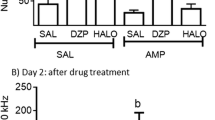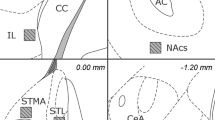Abstract
Adjunctive behaviors refers to behaviors that are “out of context” and/or excessive in amount. The terminology was first used for unexplained behaviors associated with food pellet ratio contingencies in food deprived rats (Falk, 1971). Clinically, unrelated and complex excessive behaviors were also noted with brainstem and diencephalic discharges (Andy, 1986, 1989 and 1995; Andy and Jurko, 1986).
The objective of this study was to develop a model of brainstem generated adjunctive behaviors in the rat.
Method: Sixty-one adult rats were used. Kindling was induced by mechanical and DC electrical perturbations in the midbrain. Nine different treatment groups were established in which lesions and drugs were used separately and in different combinations. Cocaine was used to accentuate, and dextrorphan to attenuate the kindling process. Behaviors were visually analyzed and recorded by video camera; they were not quantified. DC stimulation and EEGs were done with Grass instruments. Recording and stimulation sights were verified histologically.
Results: A total of 45 different behaviors were elicited. DC stimulation kindled subjects had significantly more behaviors than did electrode insertion alone and cocaine alone. However, cocaine combined with DC stimulation increased the number and intensity of the kindled behaviors. Dextrorphan tended to facilitate catatonic and sleep states. Behaviors occurred randomly and were unrelated, even when they occurred in clusters. The behaviors were associated with four abnormal EEG discharge patterns.
Conclusion: We speculate that brainstem behaviors are innate adjunctive drives that are generated in the brainstem reticular formation. They are monitored by the cortex and partially modified by environmental and cortical inputs.
Similar content being viewed by others
References
Andy, O.J. (1986). Chronic pain as a reticular formation syndrome.The Pavlovian Journal of Biological Science 21: 50–59.
Andy, O.J. (1989). Post concussion syndrome: Brainstem seizures, a case report.Clinical Electroencephalography 20: 24–34.
Andy, O.J. (1995). Mesothalamic discharge in a chronic pain, allergy and fluid retention syndrome, a case report.Integrative Physiological and Behavioral Science 30: 157–168.
Andy, O.J. and Jurko, M.F. (1986). Seizure control by mesothalamic reticular stimulation.Clinical Electroencephalography 17: 52–60.
Falk, J. (1971). Theoretical review. The nature and determinants of adjunctive behavior.Physiology of Behavior 6: 577–588.
Flint, J., Corley, R., DeFries, J.C., Fulker, D.W., Gray, J.A., Miller, S., and Collins, A.C. (1995). A simple genetic basis for a complex psychological trait in laboratory mice.Science 269: 1432–1435.
Glantz, S.A. (1992).Primer of Biostatistics. 3rd edition. New York: McGraw-Hill Book Company Inc., pp. 344–350.
Hess, W.R. (1954).Diencephalon; Autonomic and extrapyramidal functions. New York: Grune and Stratton.
Hess, W.R. (1956).Hypothalamus und thalamus; Experimental dokumente. Stuttgart: George Thieme Verlag.
Loscher, W., Horstermann, D., Honack, D., Rundfeldt, C., and Wahnschaffe, U. (1993). Transmitter amino acid levels in rat brain regions after amygdala-kindling or chronic electrode implantation without kindling: Evidence for a pro-kindling effect of prolonged electrode implantation.Neurochemical Research 18(7): 775–781.
Pellegrino, L.J., and Cushman, A.J. (1967)A stereotactic Atlas of the Rat Brain. New York: Appleton-Century-Crofts.
Qian, X., Andy, O.J., Dearman, C., Andrews, M. and Rockhold, R.W. (1992). Cocaine-induced brainstem seizures and behavior.Integrative Physiological and Behavioral Science 27: 117–129.
Rockhold, R.W., Oden, G., Ho, I.K., Andrew, M., and Farley J.M. (1991) Glutamate receptor antagonists block cocaine-induced convulsions and death.Brain Research Bulletin 27:721–723.
Rockhold, R.W., Surrett, R.S., Oden, G., Acuff, C.G., Zhang, T., Farley, J.M., Hoskins, B., and Ho, I.K. (1992) Inhibition of cocaine intoxication by excitatory amino acid receptor antagonists.Annals of the New York Academy of Sciences 648:335–337.
Scheibel, M.E. and Scheibel, A.B. (1958) Structural substrates for integrative patterns in the brain stem reticular core. In H.H. Jasper, L.D. Proctor, R.S. Kinghton, W.C. Noshay and R.T. Costello (Eds.),Reticular formation of the brain. Boston: Little, Brown, pp. 31–68.
Scheibel, M.E. and Scheibel, A.B. (1968) The brain stem reticular core—An integrative matrix. In M.D. Mesarovic (Ed.),Systems Theory and Biology. New York: Springer-Verlag, pp. 261–285.
Tinbergen, N. (1952). “Derived” activities; their causation, biological significance, origin, and emancipation during evolution.The Quarterly Review of Biology 27: 1–32.
Trube, G. and Netzer, R. (1994). Dextromethorphan: Cellular effects reducing neuronal hyperactivity.Epilepsia 35(Suppl. 5): 62–67.
Author information
Authors and Affiliations
Rights and permissions
About this article
Cite this article
Andy, O.J., Qian, XB., Lundien, M. et al. Adjunctive brainstem behaviors in the rat. Integrative Physiological and Behavioral Science 31, 315–330 (1996). https://doi.org/10.1007/BF02691435
Issue Date:
DOI: https://doi.org/10.1007/BF02691435




